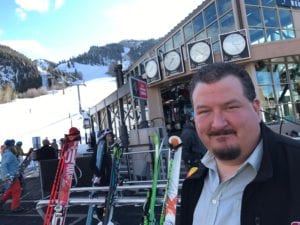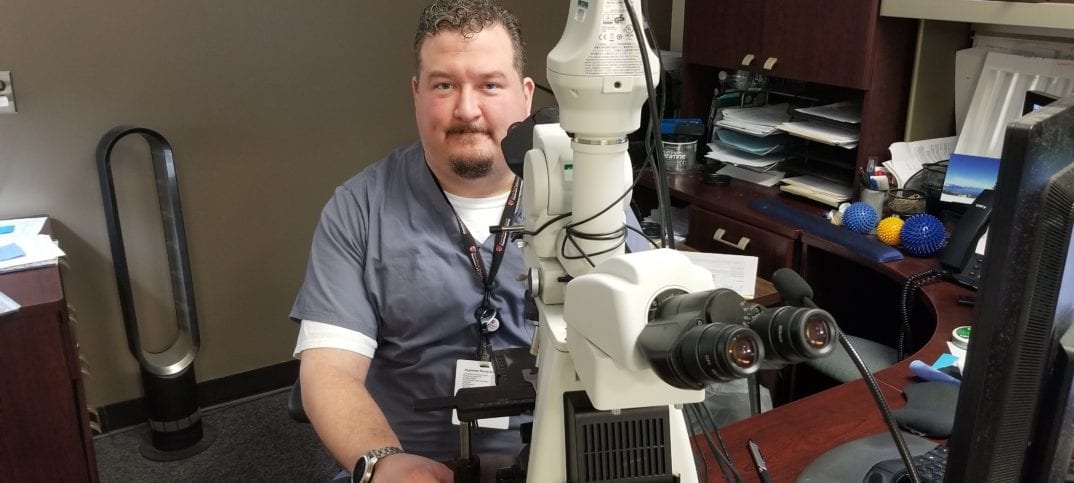By Daniel Dunaief
At first, people didn’t believe it. Now, it seems, they are eager to learn more.
Working with a talented team that included postdoctoral researchers, doctoral students and doctors, Kenneth Shroyer, the chairman of the Department of Pathology at Stony Brook University, noticed something odd about a protein that scientists thought played a supporting role, but that, as it turns out, may be much more of a villain in the cancer story.
Known as keratin 17, this protein was thought to act as a tent pole, providing structural support. That, however, isn’t the only thing it can do. The co-director of Shroyer’s lab, Luisa Escobar-Hoyos, found that this protein was prevalent in some types of cancers. What’s more, the protein seemed to be in higher concentration in a more aggressive form of the disease.
Now, working with Long Island native Daniel Mockler, a clinical assistant professor in the Department of Pathology, Shroyer and his team discovered that the presence of this particular protein has prognostic value for endocervical glandular neoplasia, suggesting the likely course of the disease.
Published in the American Journal of Clinical Pathology, the article by Mockler and his team in the Sept. 1, 2017, issue attracted the attention of pathologists around the world. It ranked as the third highest read article in the final month of 2017, according to Medscape. It was behind two other papers that were review articles, which made it the most read primary research report in pathology in December.
The response “did exceed my expectations,” Mockler stated in an email. “I would have thought [Shroyer’s earlier] paper showing that k17 can function in gene regulation would have been more popular. But I guess this [new paper] illustrates that topics that have a possible direct impact on practicing surgical pathologists will draw a lot of attention.”
To be sure, while the recent study is an early indication of the potential predictive value of this protein, there may be some mitigating factors that could affect its clinical applicability.
“It’s premature to know what the clinical utility of this marker will be,” Shroyer said. “To determine that would require a large-scale prospective clinical trial” that would involve other patient populations and other laboratories.
Still, depending on the outcome of research currently underway in Shroyer’s lab, the protein may offer a way of determining the necessary therapy for patients with the same diagnosis.
Doctors don’t want to give patients with milder version of the disease high levels of chemotherapy, which would cause uncomfortable side effects. At the same time, they want to be as aggressive as possible in treating patients whose cancers are likely a more significant threat.
“The goal of having an excellent prognostic biomarker … is to avoid over and under treatment of patients,” suggested Mockler, who is also an attending pathologist at SBU and Stony Brook Southampton.
Shroyer was delighted with the efforts of the team that put together this well-read research. “As is true of all our clinical faculty, I want to give them every opportunity to take advantage of their ability to collaborate with research faculty in our department and throughout the cancer center and the school of medicine to advance their scholarly careers and academic productivity,” he said.
Mockler’s success and the visibility of this paper is “an excellent example of how someone with a busy clinical practice can also have a major impact on translational research,” Shroyer added.
Mockler appreciated the support and work of Escobar-Hoyos, who had conducted her doctoral research in Shroyer’s lab. She has “been the main driving force, along with [Shroyer] in the initial discovery of k17 including its prognostic implications as well as its possible function in regulating gene expression,” he said.
Mockler said he spends about 80 percent of his time on patient care, with the remaining efforts divided between research and academic pursuits. His first priority is providing “excellent patient care.”
Working with Shroyer and Escobar-Hoyos, Mockler explained that they have started looking at k17 in organ systems including the esophagus, pancreas and bladder. “We are currently looking at k17 from a diagnostic point of view in regards to bladder cancer,” he said. “Discoveries that impact the daily signout of surgical pathologists by allowing us to make better and more consistent diagnoses interests me very much.”
A resident of Kings Park, Mockler, who grew up in Hicksville, lives with his fiancée Danielle Kurkowski, who is a medical technologist of flow cytometry research and development at ICON Central Laboratories in Farmingdale.

Outside of his work in medicine, Mockler is an avid snowboard enthusiast. He tries to get in as many trips as possible during the winter, including a vacation a few weeks ago to the Austrian Alps. A more typical trip, however, is to western mountains or to Vermont, including Killington, Okemo and Stratton.
“To blow off steam and relax, nothing is better than being on a snow-covered mountain,” he said.
Mockler is pleased with the developments in the department. He has seen the “research goals of the department change quite significantly,” adding that Shroyer has “done a tremendous amount of recruiting.”
Mockler suggests to residents that it’s “good to get involved. I always tell them that [Shroyer] has a pretty active research lab and he likes it when residents get involved.”
As for his work on k17, Mockler is pleased that he’s been able to contribute to the ongoing efforts. Shroyer “has been doing this a while and I have seen the excitement and energy he has put into k17,” he explained, “so I know that we are onto something big.”
And so, apparently, do readers of pathology journals.







